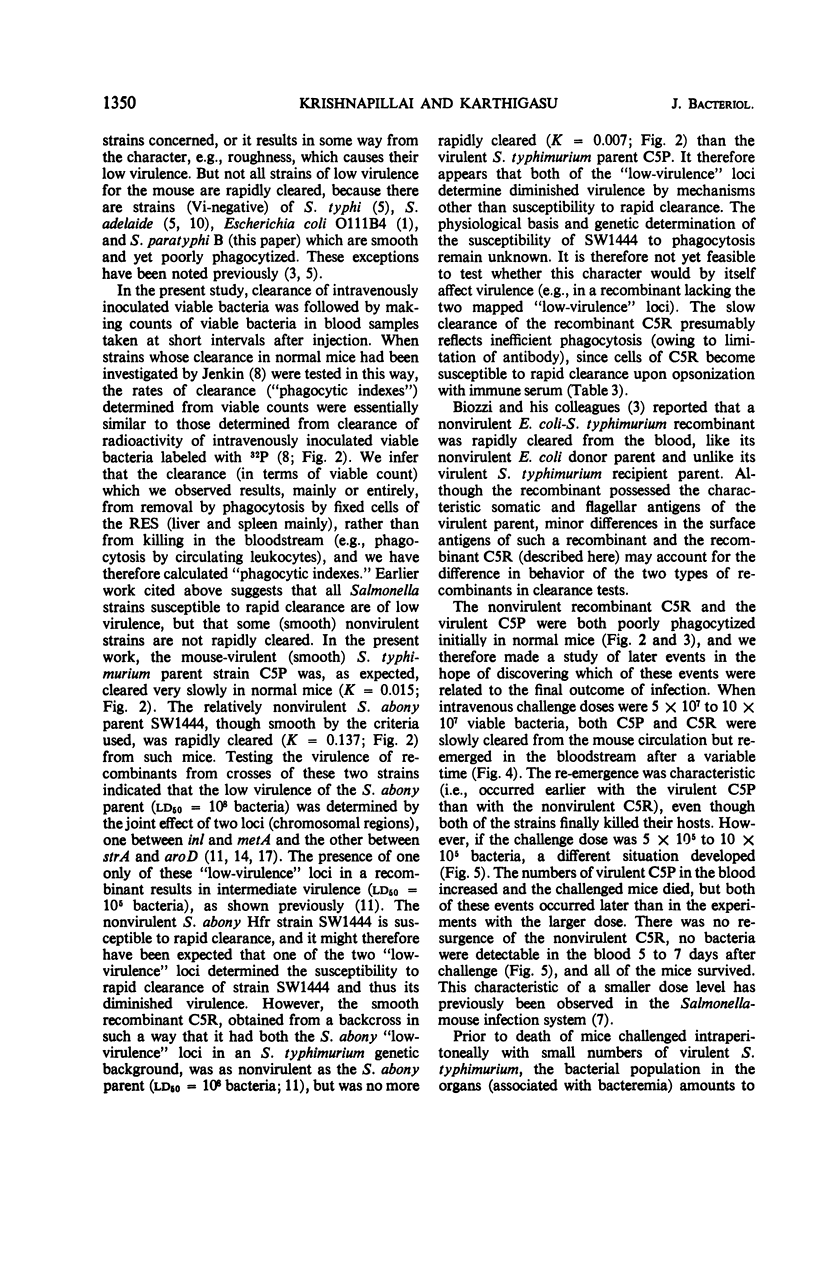Abstract
A previous genetic investigation involving a mouse-nonvirulent Salmonella abony donor (high frequency of recombination) and a virulent S. typhimurium recipient indicated that two unlinked “low-virulence” loci determined nonvirulence. A nonvirulent recombinant was analyzed to determine the basis for its nonvirulence. The recombinant was smooth (like the parental strains) and prototrophic. The doubling time in mouse serum of the recombinant and the S. abony parent (both streptomycin-resistant) was longer than that of the wild-type streptomycin-sensitive ancestor of the S. typhimurium recipient. The virulent recipient also grew poorly in serum. However, the nonvirulence of the recombinant was probably not due to its inheritance of the streptomycin-resistance allele from the donor, because other recombinants were streptomycin-resistant but still virulent. Unlike the nonvirulent S. abony (but like the S. typhimurium), the recombinant was insusceptible to rapid intravenous clearance in normal mice. It therefore appears that neither of the “low-virulence” loci determine diminished virulence by enhancing phagocytosis. Clearance of the recombinant was enhanced by opsonization with immune serum. Counts of viable bacteria in the blood, liver, and spleen of normal mice after intravenous challenge showed that the recombinant, like the S. abony donor, failed to proliferate in the tissues, whereas the virulent S. typhimurium did so markedly. It is concluded that the nonproliferation of the recombinant was determined by one or both of the “low-virulence” loci from the nonvirulent S. abony donor.
Full text
PDF








Selected References
These references are in PubMed. This may not be the complete list of references from this article.
- BENACERRAF B., SEBESTYEN M. M., SCHLOSSMAN S. A quantitative study of the kinetics of blood clearance of P32-labelled Escherichia coli and Staphylococci by the reticuloendothelial system. J Exp Med. 1959 Jul 1;110(1):27–48. doi: 10.1084/jem.110.1.27. [DOI] [PMC free article] [PubMed] [Google Scholar]
- BIOZZI G., HOWARD J. G., HALPERN B. N., STIFFEL C., MOUTON D. The kinetics of blood clearance o isotopically labelled Salmonella entertidis by the reticulo-endothelial system in mice. Immunology. 1960 Jan;3:74–89. [PMC free article] [PubMed] [Google Scholar]
- BIOZZI G., LEMINOR L., STIFFEL C., MOUTON D., DAOULAS F. CORRELATION BETWEEN VIRULENCE AND PHAGOCYTOSIS OF GENETIC RECOMBINANT BETWEEN ESCHERICHIA COLI AND SALMONELLA TYPHIMURIUM. Nature. 1964 May 23;202:819–820. doi: 10.1038/202819b0. [DOI] [PubMed] [Google Scholar]
- BIOZZI G., STIFFEL C., LEMINOR L., MOUTON D., BOUTHILLIER Y. ETUDE QUANTITATIVE DE L'EFFET OPSONISANT DES IMMUNS'ERUMS SUR LA PHAGOCYTOSE DES SALMONELLA PAR LES CELLULES DU SYST'EME R'ETICULO-ENDOTH'ELIAL IN VIVO. Ann Inst Pasteur (Paris) 1963 Oct;105:635–666. [PubMed] [Google Scholar]
- FURNESS G., ROWLEY D. Transduction of virulence within the species Salmonella typhimurium. J Gen Microbiol. 1956 Aug;15(1):140–145. doi: 10.1099/00221287-15-1-140. [DOI] [PubMed] [Google Scholar]
- HOBSON D. The behaviour of a mutant strain of Salmonella typhimurium in experimental mouse typhoid. J Hyg (Lond) 1957 Sep;55(3):322–333. doi: 10.1017/s0022172400037232. [DOI] [PMC free article] [PubMed] [Google Scholar]
- JENKIN C. R. An antigenic basis for virulence in strains of Salmonella typhimurium. J Exp Med. 1962 Apr 1;115:731–743. doi: 10.1084/jem.115.4.731. [DOI] [PMC free article] [PubMed] [Google Scholar]
- JENKIN C. R., ROWLEY D. PARTIAL PURIFICATION OF THE "PROTECTIVE" ANTIGEN OF SALMONELLA TYPHIMURIUM AND ITS DISTRIBUTION AMONGST VARIOUS STRAINS OF BACTERIA. Aust J Exp Biol Med Sci. 1965 Feb;43:65–78. doi: 10.1038/icb.1965.5. [DOI] [PubMed] [Google Scholar]
- JENKIN C. R., ROWLEY D. The role of opsonins in the clearance of living and inert particles by cells of the reticuloendothelial system. J Exp Med. 1961 Sep 1;114:363–374. doi: 10.1084/jem.114.3.363. [DOI] [PMC free article] [PubMed] [Google Scholar]
- KRISHNAPILLAI V., BARON L. S. ALTERATIONS IN THE MOUSE VIRULENCE OF SALMONELLA TYPHIMURIUM BY GENETIC RECOMBINATION. J Bacteriol. 1964 Mar;87:598–605. doi: 10.1128/jb.87.3.598-605.1964. [DOI] [PMC free article] [PubMed] [Google Scholar]
- MAKELA P. H. HFR males in Salmonella abony. Genetics. 1963 Mar;48:423–429. doi: 10.1093/genetics/48.3.423. [DOI] [PMC free article] [PubMed] [Google Scholar]
- Mäkelä P. H., Ziegler L. An F' episome of Salmonella abony. Acta Pathol Microbiol Scand. 1966;67(4):547–554. doi: 10.1111/apm.1966.67.4.547. [DOI] [PubMed] [Google Scholar]
- ROANTREE R. J., STEWARD J. P. MUTATIONS TO PENICILLIN RESISTANCE IN THE ENTEROBACTERIACEAE THAT AFFECT SENSITIVITY TO SERUM AND VIRULENCE FOR THE MOUSE. J Bacteriol. 1965 Mar;89:630–639. doi: 10.1128/jb.89.3.630-639.1965. [DOI] [PMC free article] [PubMed] [Google Scholar]
- Sanderson K. E. Revised linkage map of Salmonella typhimurium. Bacteriol Rev. 1967 Dec;31(4):354–372. doi: 10.1128/br.31.4.354-372.1967. [DOI] [PMC free article] [PubMed] [Google Scholar]
- Wilkinson R. G., Stocker B. A. Genetics and cultural properties of mutants of Salmonella typhimurium lacking glucosyl or galactosyl lipopolysaccharide transferases. Nature. 1968 Mar 9;217(5132):955–957. doi: 10.1038/217955a0. [DOI] [PubMed] [Google Scholar]


